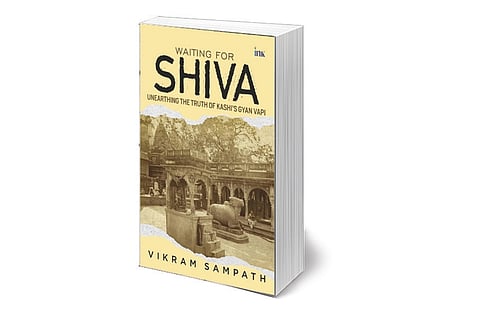Book review | Waiting for Shiva: Unearthing the Truth of Kashi’s Gyan Vapi- Sacred resurrection
Vikram Sampath’s Waiting for Shiva: Unearthing the Truth of Kashi’s Gyan Vapi, explores Hindu resilience, resurrection and reclamation amid historical challenges. It prompts readers to contemplate the vitality of Hinduism throughout Indian civilisation, yet also confront the complex histories, such as those surrounding Kashi’s Gyan Vapi. It delves into the journey of the sacred place, for both Hindus and Muslims, providing insights into cultural, religious and political dynamics surrounding it.
“The tragedy in India, especially after Independence, was to deny and denounce this umbilical cord at the misplaced altar of secularism,” writes Sampath. Hinduism, however, seeks to unify a culturally diverse nation under a common identity. It reflects the ancient Indian concept of dharma. The politicisation of Hindu identity has led to tensions between communities in India. Events such as the Ayodhya dispute over the Babri Masjid, or Gyan Vapi, underscore the complexities of religious identity and societal cohesion.
Sampath is not dismissive of criticism of Congressmen and Marxist historians for spreading falsehoods about events such as the Kashi Vishwanath temple and Mathura’s Krishna janmasthan. According to him, their narratives demonised Brahmins, undermined Hinduism, and excused Islamic bigotry. Nevertheless, he emphasises creating an alternate body of work that challenges such historical distortions.
The book highlights the events of 1810, when communal riots led to the destruction of the Gyan Vapi mosque. It shifts to the legal battles over the site, particularly the ‘Deen Muhammad vs The State’ case of 1936, where Muslims sought the right to perform prayers in the complex. The court, however, ruled against them, stating that the site was not Waqf property, and that prayers on usurped land without permission are forbidden in Islamic law. The discussion highlights the twists and turns in the proceedings, with the entire narrative underscoring the significance of archaeological surveys and evidence in establishing the site’s religious character.
Sampath emphasises the Hindu consciousness surrounding Kashi. He highlights examples from Bengal to Gujarat, showcasing how Kashi held significance across India, and goes on to talk about its universal reverence by bringing in the Jain and Sikh communities as well.
While the book is a compelling exploration of Hindu consciousness, the timing of its release may contribute to politicising historical narratives for contemporary gains, potentially lending an advantage to the ruling BJP dispensation. It, therefore, makes it crucial for readers to approach the book with a critical lens, considering its broader socio-political context and implications in the current Indian landscape.
‘Ignoring History Perpetuates Social Schisms’
Vikram Sampath speaks to Soumya Bhowmick about his new book, Waiting for Shiva, and whether its release ahead of the Lok Sabha polls can politicise historical narratives.
This book was published relatively faster than your other works. How did you include such detailed historical accounts of Kashi’s Gyan Vapi in such a short time frame?
The rapid publication of Waiting for Shiva indeed surprised me. I feel like the book wasn’t entirely my doing. The project demanded a departure from my usual historical research methods. In addition to archival and colonial records, accessing primary sources in their original language was paramount. So, I spent countless hours with experts navigating Sanskrit texts and theological intricacies.
Why has the politicisation of Hindu consciousness been such a significant issue for India?
The politicisation of Hindu consciousness has indeed been a significant issue for India, but it's crucial to recognise that this isn't a new phenom- enon. The struggle over sacred sites like Kashi has a long history, with various rulers and communities asserting their claim over them throughout the centuries. As for the distortion of history, it's important to understand that current political affilia- tions shouldn't overshadow the broader historical context. As a historian, I'm more interested in understanding the deeper societal structures and the common people's connections to these sacred spaces.
There's been a persistent effort by, what I term, the 'Nehruvian Marxist' consensus to create an idea of India that divorces itself from its rich religious and cultural heritage. This has led to a reluctance to confront uncomfortable truths from history under the guise of maintaining social harmony Ignoring historical, however, realities only perpetuates social schisms. It's time to break free from the shackles of political correctness
What is your opinion on the geographical divisions of Hindu consciousness in India, and how has it changed over time?
The concept of a unified Hindu consciousness is not a recent development. Even in ancient times, we see evidence of a shared cultural and spiritual identity transcending regional differences. Adi Shankaracharya, for instance, travelled extensively across the subcontinent, establishing maths. Similarly, we find instances of devotion to Lord Ram that are not confined to a region. The notion of north-south differences in Hindu consciousness is a colonial construct perpetu- ated even after independence. In reality, our shared cultural heritage has always connected us as a nation. The recent resurgence of Hindu con- sciousness is perhaps a reaffirmation of these timeless values in the face of historical distortions.
How do you think the Indian audience will perceive the timing of release of Waiting for Shiva?
My focus remains firmly on the cultural, historical and societal implications rather than the political context. While politics inevitably permeates many aspects of Indian society, what is genuinely encouraging is the growing openness and curiosity, especially among young readers, to engage with dense subjects like history and identity India has evolved significantly, and those in positions of influence must recognise and acknowledge this bottom-up transformation. So, while the political backdrop adds an intriguing layer, the broader societal shifts and the thirst for truth truly define the significance of the book's release at this juncture.

